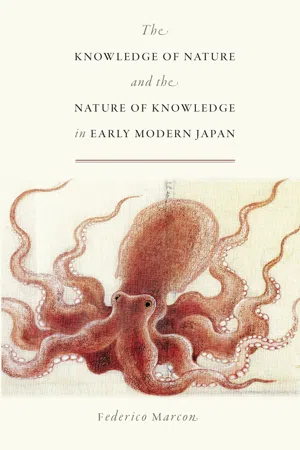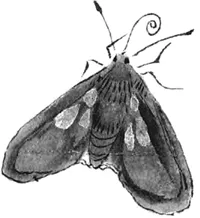![]()
PART I Introduction
Philosophy persistently and with the claim of truth, must proceed interpretively without ever possessing a sure key to interpretation. . . . The text which philosophy has to read is incomplete, contradictory and fragmentary.
— Theodor W. Adorno, “The Actuality of Philosophy”
![]()
1 Nature without Nature
Prolegomena to a History of Nature Studies in Early Modern Japan
DISENCHANTING NATURE
The Hitachi no kuni fudoki (Gazetteer of the Hitachi Province, 721 CE) narrates that during the reign of the emperor Keitai, who ruled at the beginning of the sixth century,
there was a man called Yahazu of the Matachi clan who reclaimed a marshy land in a valley west of the District Office to open up new rice-fields. Soon, a troop of Yatsu no kami gathered together to obstruct his work and hinder the opening of new fields to cultivation. According to the people of the area, Yatsu no kami are snake-like spirits. They have bodies of snakes and horns on their heads. If anyone turns to look at them while escaping, his household would be ruined and he would die without heirs. Fields neighboring the District Office harbor many of these creatures.
Matachi was furious: he put on his armor, took his halberd, and killed many of them, driving the rest away. Later, he went to the mountain entrance and erected some sticks to mark a boundary. He then said to the Yatsu no kami: “The Deities shall live in the lands above this point towards the mountain; humans shall instead cultivate their fields below it. From now on I shall become a priest to worship you and so will my descendants do forever and ever. I beseech you not to curse me or bear a grudge against me.”
He built a shrine and conducted the first ceremony. Then, he opened up more than ten cho of rice-fields. His descendants continued generation after generation to worship these deities, and so are still doing today.1
Matachi’s tale discloses a pattern that characterized the religious beliefs and mythological stories of various communities of early Japan, consisting of a fundamental division of human and sacred space. On one side, human dwellings and cultivated lands formed the symbiotic domain of a nature domesticated to human needs; on the other, dark forests and impenetrable mountains were the realm of wild animals and untamed spirits, a nature inhospitable to humans. In between, shrines and wooden torii gates marked the borders that kept the two worlds separated: they signaled to human wanderers that if they proceeded further, they entered at their own risk in the hostile reign of wild animals and kami (spirits), and they reminded deities of a pact of coexistence with human beings—a pact that usually originated, as in the story from the Hitachi no kuni fudoki, from a violent clash of human communities and natural spirits.
The sacred space of untamed nature is inhospitable and alien to human beings. It is populated by a variety of trees, herbs, and animals but also by kami and other monstrous creatures like kappa (water goblins), tengu (long-nosed demons), kitsune (supernatural foxes), and tanuki (raccoon dogs), which tricked, kidnapped, challenged in wrestling matches, and sometimes killed all those humans who dared to enter their realm.2 Folk tales abound of such creatures, and many Shinto shrines worship one or the other of these supernatural creatures “pacified” to allow human beings to enjoy the natural riches of an area—like in the case of Matachi’s story.3 Shrines protect the impermeability of the borders between human and sacred space, and they control through ritual protocols of worship the divine forces that humans had subdued. Shinto rituals include tama shizume (pacification of spirits) and jijinsai (pacification of place), ceremonies performed even today before constructing new buildings or opening up new lands for cultivation. Shinto shrines thus function as signposts of a separation of the human and the natural worlds.
Anthropologists and ethnographers of Japan have often argued that the mountainous landscape of the major Japanese islands reproduces a similar division of space: villages and cities surrounded by cultivated lands and encircled by village mountains (satoyama)—reservoirs of timber, firewood, and hunting and gathering resources—constitute the human space; outside it, forest-covered mountains with sparse or no human presence. Shinto shrines punctuate this concentric organization of space with a system of village shrines (sato no miya), field shrines (ta no miya), and mountain shrines (yama no miya), in which people worshiped those spirits enraged by the opening up of new lands for human exploitation; small shrines (oku no miya), built to mark the borderline between the human space and the sacred space of untamed nature, lie on the outer ring.4
In the last century, scholars of various disciplines—from Yanagita Kunio’s ethnographical research to Nakao Sasuke’s biogeography and Sonoda Minoru’s Shinto environmentalism—have mobilized this pattern of spatial division to create and sustain an ideological constellation of beliefs according to which a unified and unique Japanese identity in empathic relation with the natural environment have always existed substantially unaffected by historical change.5 Even though evidences suggest that a ritual separation of natural (or sacred) and human spheres can be retrieved throughout the history of Japan,6 recent research on the environmental history of the archipelago have shown how, in actual fact, the destruction of the environment has been a constant feature of Japanese history since its earliest times precisely because, rather than despite, the existence of a religious rituality that sublimated human intervention on nature.7 For example, economic and purely damage control–related concerns, rather than religious “love for nature,” were at the core of the reforestation policies of the Tokugawa shogunate in the eighteenth and nineteenth centuries.8
This book reconstructs various processes that slowly but relentlessly demolished this traditional division of space and the worldviews that sustained it.9 It shows how a series of disparate intellectual and manual practices, spanning from the late sixteenth to the mid-nineteenth century, on the one hand favored the expansion of the human domain to include pristine mountains and forests as reservoirs of material and cognitive resources and on the other hand developed new ways of conceptualizing natural species and their environment. The vanishing of the invisible texture of metaphysical relations that held together sacred and human spaces was the effect of a long, unplanned, and contingent series of intellectual, economic, political, and cultural processes. A variety of disciplines of nature studies more or less directly associated with honzōgaku—a scholarly field that encompassed subjects ranging from materia medica and agronomy to natural history—knitted together these processes. The ensuing secularization of nature sprang from a parceling of nature in myriads of discrete objects to be described, analyzed, consumed, or accumulated in the form of standardized and quantifiable units as products, natural species, or collectibles.10
Because I am mainly concerned with the changing attitudes toward the material environment in early modern Japan, I do not develop here a comprehensive history of the discipline of honzōgaku.11 Rather, I follow some genealogies of its complex history to reveal its impact on the professionalization of specialized scholars; agricultural advancements; the development of new economic policies in shogunal and domainal administrations; and the formation of various forms of popular entertainments, refined pastimes, artistic creations, and intellectual discourses related to plants and animals. I claim that these were all interrelated processes that played a critical role in the secularization of nature and the objectification of the natural species that populated Japan. On the one hand, the increasing commercialization of agricultural production—which included the farming of rice and other grains as well as protoindustrial activities like fishery, textiles, sake brewing, dyeing, mining, and so on—led to the commodification of plants and animals and their transformation in resources to inventory and accumulate for the needs of agricultural growth and the demands of the expanding market of medicinal substances. On the other hand, honzōgaku scholars and amateurs tended to examine plants and animals as intellectual commodities in isolation from their ecosystems, to be cataloged as concrete samples of abstract species in encyclopedias, atlases, monographs, and collections. This tendency derived in part from the adherence of early honzōgaku scholars to the explanatory style of canonical texts like Honzō kōmoku, which tended to treat mineral, vegetal, and animal species as meibutsu (names) in the form of discrete encyclopedic entries revealing their pharmacological properties. The description and manipulation of individual specimens disconnected from their ecosystem developed in concomitance with the recruitment of naturalists in state-funded missions to inventory plants and animals as sanbutsu (products, resources) and to experiment with medicinal herbs (yakuhin) and pest-resistant crops in botanical gardens. A burgeoning popular interest in plants and animals contributed to their transformation into objects of curiosity (kōbutsu) to be collected, admired, exchanged, and exhibited as spectacles (misemono).
Whether to expand the encyclopedic reach of human knowledge or to be engaged in a morally uplifting practice, whether to improve agricultural production or to generate new aesthetically appealing images, or whether for social utility or simply for fun, professional and amateur scholars collected, observed, bred, exchanged, analyzed, compared, depicted, described, fantasized on, and classified the most varied assortments of insects and fish, herbs and mushrooms, and trees and flowers, following either theoretical or practical protocols in both solitary and collegial enterprises. A majority of honzōgaku scholars favored a lexicographical approach, accumulating knowledge and gathering information from books and encyclopedias. But from the beginning of the eighteenth century, a growing number of naturalists started to invade pristine and uncharted forests, mountains, and ravines to make complete inventories of the vegetal and animal species they contained. To these scholars, nature was no longer conceivable as an organic, meaningful, and homopoietic space of supernatural and mystifying relations but as a multitude of objects—myriads of things (banbutsu). As one of these naturalists, Kaibara Ekiken, put it, “I climbed tall mountains. I penetrated into deep valleys. I followed steep paths and walked through dangerous grounds. I have been drenched by rains and lost my way in fog. I endured the coldest winds and the hottest sun. But I was able to observe the natural environment of more than eight hundred villages.”12
THE OBJECTIFICATION OF NATURE
At once material and intellectual commodities, plants and animals constituted, as specimens, the myriads of things that populated the world (banbutsu). But as species to be studied, produced, or exchanged, plants and animals became concrete bearers of abstract characteristics. Different social practices converted them into names (meibutsu) of natural kinds in encyclopedias and atlases, into pr...

